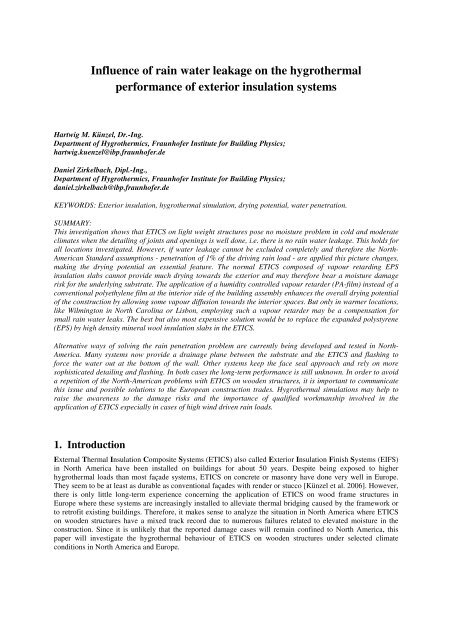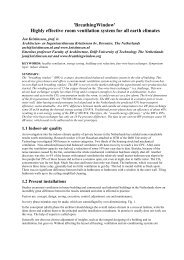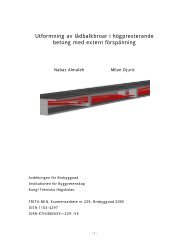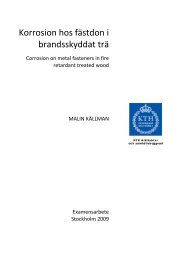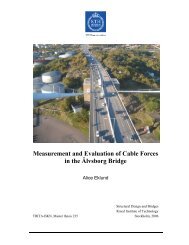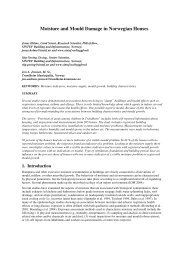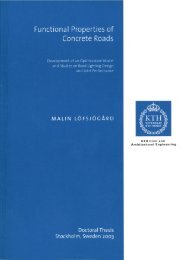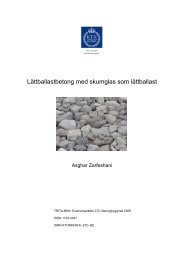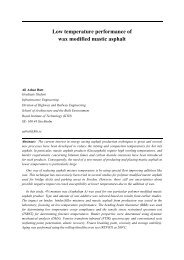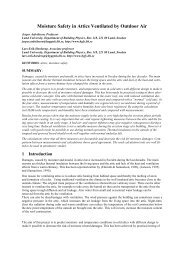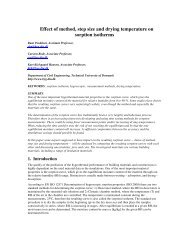Read complete article here
Read complete article here
Read complete article here
You also want an ePaper? Increase the reach of your titles
YUMPU automatically turns print PDFs into web optimized ePapers that Google loves.
Influence of rain water leakage on the hygrothermal<br />
performance of exterior insulation systems<br />
Hartwig M. Künzel, Dr.-Ing.<br />
Department of Hygrothermics, Fraunhofer Institute for Building Physics;<br />
hartwig.kuenzel@ibp.fraunhofer.de<br />
Daniel Zirkelbach, Dipl.-Ing.,<br />
Department of Hygrothermics, Fraunhofer Institute for Building Physics;<br />
daniel.zirkelbach@ibp.fraunhofer.de<br />
KEYWORDS: Exterior insulation, hygrothermal simulation, drying potential, water penetration.<br />
SUMMARY:<br />
This investigation shows that ETICS on light weight structures pose no moisture problem in cold and moderate<br />
climates when the detailing of joints and openings is well done, i.e. t<strong>here</strong> is no rain water leakage. This holds for<br />
all locations investigated. However, if water leakage cannot be excluded <strong>complete</strong>ly and t<strong>here</strong>fore the North-<br />
American Standard assumptions - penetration of 1% of the driving rain load - are applied this picture changes,<br />
making the drying potential an essential feature. The normal ETICS composed of vapour retarding EPS<br />
insulation slabs cannot provide much drying towards the exterior and may t<strong>here</strong>fore bear a moisture damage<br />
risk for the underlying substrate. The application of a humidity controlled vapour retarder (PA-film) instead of a<br />
conventional polyethylene film at the interior side of the building assembly enhances the overall drying potential<br />
of the construction by allowing some vapour diffusion towards the interior spaces. But only in warmer locations,<br />
like Wilmington in North Carolina or Lisbon, employing such a vapour retarder may be a compensation for<br />
small rain water leaks. The best but also most expensive solution would be to replace the expanded polystyrene<br />
(EPS) by high density mineral wool insulation slabs in the ETICS.<br />
Alternative ways of solving the rain penetration problem are currently being developed and tested in North-<br />
America. Many systems now provide a drainage plane between the substrate and the ETICS and flashing to<br />
force the water out at the bottom of the wall. Other systems keep the face seal approach and rely on more<br />
sophisticated detailing and flashing. In both cases the long-term performance is still unknown. In order to avoid<br />
a repetition of the North-American problems with ETICS on wooden structures, it is important to communicate<br />
this issue and possible solutions to the European construction trades. Hygrothermal simulations may help to<br />
raise the awareness to the damage risks and the importance of qualified workmanship involved in the<br />
application of ETICS especially in cases of high wind driven rain loads.<br />
1. Introduction<br />
External Thermal Insulation Composite Systems (ETICS) also called Exterior Insulation Finish Systems (EIFS)<br />
in North America have been installed on buildings for about 50 years. Despite being exposed to higher<br />
hygrothermal loads than most façade systems, ETICS on concrete or masonry have done very well in Europe.<br />
They seem to be at least as durable as conventional façades with render or stucco [Künzel et al. 2006]. However,<br />
t<strong>here</strong> is only little long-term experience concerning the application of ETICS on wood frame structures in<br />
Europe w<strong>here</strong> these systems are increasingly installed to alleviate thermal bridging caused by the framework or<br />
to retrofit existing buildings. T<strong>here</strong>fore, it makes sense to analyze the situation in North America w<strong>here</strong> ETICS<br />
on wooden structures have a mixed track record due to numerous failures related to elevated moisture in the<br />
construction. Since it is unlikely that the reported damage cases will remain confined to North America, this<br />
paper will investigate the hygrothermal behaviour of ETICS on wooden structures under selected climate<br />
conditions in North America and Europe.
2. Composition of External Thermal Insulation Composite Systems<br />
ETICS in North America usually closely resemble those in Europe. The standard composition of an ETICS is<br />
shown in Fig. 1. The ETICS is usually fastened to the exterior sheathing of a wood stud wall or on a masonry<br />
wall. In most ETICS expanded Polystyrene (EPS) is used as insulation material. The use of high-density mineral<br />
fiber insulation which is also quite common in Europe is practically unknown in North America. On top of the<br />
insulation slabs a polymer modified base coat including a reinforcing glass fiber mesh are applied, followed by a<br />
finish coat. The reinforced base coat together with the finish or top coat is usually 5 to 10 mm thick.<br />
Sheathing<br />
Adhesive<br />
Rigid Insulation Board<br />
Base Coat with<br />
Reinforcing Mesh<br />
Finish Coat<br />
Fig. 1: Composition of a typical External Thermal Insulation Composite System<br />
3. Track record of ETICS<br />
In the middle of the 90s the first substantial damage cases associated with ETICS were reported from North<br />
Carolina. Similar reports from other regions with high precipitation intensities (e.g. Seattle, Vancouver)<br />
followed. The moisture problems occurred mostly at the exterior sheathing boards that served as substrate for the<br />
ETICS. Pictures of rotten OSB or disintegrated gypsum board quickly spread among the building community<br />
and forced manufactures to react [Nisson & Best 1999]. A comprehensive literature review analysing more than<br />
10 investigations carried out on several objects each, comes to the following conclusions [Cheple & Huelman<br />
2000]. The main reasons for moisture damage are leaks around windows and joints w<strong>here</strong> rainwater penetrates<br />
beneath the insulation layer. However, problems due to air convection or diffusion of indoor air may also have<br />
caused elevated moisture in some cases. An aggravating factor is the low drying potential of the construction.<br />
Moisture can neither dry-out quickly to the exterior because of the vapour retarding foam insulation nor to the<br />
interior due to the usual presence of a polyethylene vapour barrier. The solutions proposed in [Cheple &<br />
Huelman 2000] are limited to managing rain water penetration by proper sloping and flashing of joints and wall<br />
openings and by applying drainable insulation systems. Sheathing materials that are sensitive to moisture such as<br />
untreated gypsum board are considered inappropriate as ETICS substrates. Other work has shown that enhancing<br />
the drying potential towards the interior spaces by an innovative vapour control strategy may also alleviate the<br />
problem [Karagiozis & Kumaran 1997].<br />
The moisture problems that occurred in North American in the 90s were not limited to walls having ETICS.<br />
Buildings with normal stucco façades (render applied on building paper over OSB or plywood) were also<br />
affected [Lawton 1999]. This resulted in a new design approach that aimed at better detailing to reduce rainwater<br />
penetration and at increasing the drying potential of the whole assembly. It has been realized that it is difficult to<br />
set-up a perfect building that will never leak. T<strong>here</strong>fore the building envelope should be designed in such a way<br />
that small leaks can be handled. Consequently the ASHARE Standard 160 on criteria for moisture design<br />
[BSR/ASHRAE 2006] states that in the absence of performance proofs it should be assumed that 1% of the wind<br />
driven rain hitting the façade is deposited on the weather resistive barrier (WRB) behind the cladding. If t<strong>here</strong> is
no WRB another layer should be selected w<strong>here</strong> the penetrating rainwater is likely to go (e.g. sheathing beneath<br />
the ETICS in Fig. 1). The selected leakage rate in this standard is not meant to be a worst case scenario. It is not<br />
based on field test results but on hygrothermal simulations (e.g. Desjarlais et al. 2001) that showed that more<br />
than 1% of rainwater penetration may be detrimental for a large portion of existing wall structures.<br />
In Europe ETICS are applied for about 50 years. More than 40 million square meters of ETICS are installed on<br />
new and existing buildings every year in Germany and severe problems or damage cases have been rare [Künzel<br />
et al. 2006]. In contrast to North America w<strong>here</strong> ETICS are mainly considered as a finish system, the purpose of<br />
ETICS in Europe is to provide adequate thermal performance of external walls that usually consist of masonry or<br />
cast-in-place concrete. T<strong>here</strong>fore the average insulation thickness is higher in Europe (approx. 100 mm in 2006)<br />
than in the U.S. (25- 50 mm). ETICS in Europe require a Technical Approval as a system ensuring harmonized<br />
system components and trained installers. However, it is doubtful that better quality control and workmanship<br />
alone can explain the huge difference in past performance of ETICS between Europe and North America. An<br />
important reason is probably the sensitivity of the substrate. While concrete and masonry readily absorb and<br />
redistribute small quantities of leakage water without any signs of degradation, the same amount of water may<br />
severely damage typical sheathing materials of North American stud walls such as OSB, plywood or gypsum<br />
board. Since ETICS have more recently been applied to wooden wall structures in Europe too, t<strong>here</strong> may also be<br />
an increase in moisture problems as the ones described in [Schulze & Radovic 1992] and [Schumacher 2006].<br />
T<strong>here</strong>fore it makes sense to investigate the moisture tolerance of wooden structures with ETICS for European<br />
construction types and climate conditions in order to prevent moisture-related problems.<br />
4. Hygrothermal simulations<br />
The transient temperature and moisture distributions in external wall assemblies with ETICS are calculated using<br />
version 4.1 of the hygrothermal simulation model WUFI ® [Künzel 1995] which has been validated many times<br />
by comparison with experimental building envelope investigations including measurements on wall structures<br />
with ETICS (e.g. [Künzel 1998a]). In order to cover North American and European building traditions the<br />
following wall assembly has been selected.<br />
• ETICS: 10 mm lamina (exterior rendering) on 60 mm EPS<br />
• Sheathing: 15 mm OSB<br />
• Cavity insulation: 160 mm glass fiber<br />
• Vapour retarder: polyethylene film (s d = 20 m) or polyamide film (0.1 m < s d < 5 m)<br />
• Interior panelling: 12 mm gypsum board (installation gap 40 mm)<br />
The material properties are taken from the WUFI ® database. The polyethylene (PE) film represents a standard<br />
vapour retarder with a diffusion resistance (s d ) of 20 m. The polyamide (PA) film is a humidity controlled vapour<br />
retarder whose diffusion resistance varies with ambient humidity conditions [Künzel 1998b]. It has been<br />
developed to enhance the drying potential of building assemblies [Künzel & Leimer 2001]. The colour of the<br />
exterior stucco is assumed to be bright (solar absorptivity 0.4).<br />
4.1 Selected locations and loads<br />
The first location considered is North Carolina w<strong>here</strong> the ETICS problems started. As representative weather<br />
conditions the meteorological data for a cold year in Wilmington are selected from the WUFI ® climate database.<br />
For Europe a sample of four locations is chosen: Hannover in the middle of Germany’s Northern plain, Lisbon at<br />
the Atlantic South-West Coast of Europe, Locarno in the Southern part of the Swiss Alps and Vienna at the edge<br />
of the East-European plain. The average temperatures and humidities as well as the annual sum of wind driven<br />
rain hitting the middle of a low-rise building at the most exposed orientation are displayed for all selected<br />
locations in Table 1. While the average relative humidity does not differ much from one location to the other, the<br />
average temperature ranges from approximately 17°C to 25°C in summer and from 0°C to 10°C in winter.<br />
Hannover is the coldest place and Wilmington and Lisbon which are the warmest locations experience the<br />
highest wind driven rain loads.<br />
The hygrothermal simulations which begin in October of the representative year are continued over a period of<br />
three years by repeatedly running through the same meteorological data-set. The initial conditions in all material<br />
layers of the building assembly are set to EMC 80 (equilibrium moisture content at 80% RH). If rainwater<br />
penetration through imperfections cannot be ruled out, 1% of the wind-driven rain load from Table 1 is deposited<br />
on the exterior surface of the OSB sheathing [BSR/ASHRAE 2006].
Table 1: Driving rain load at the surface of the most exposed façade orientation and average hygrothermal<br />
conditions at the selected locations in North America and Europe.<br />
Location<br />
Driving rain load<br />
(façade orientation)<br />
Rel. Humidity Temperature (annual/monthly mean)<br />
(annual mean) Year January July<br />
Wilmington 186 l/m²a (S) 73% 16.1 °C 5.7 °C 24.9 °C<br />
Hannover 160 l/m²a (W) 80% 8.6 °C -0.1 °C 17.1 °C<br />
Lisbon 193 l/m²a (W) 75% 15.6 °C 9.8 °C 20.7 °C<br />
Locarno 133 l/m²a (E) 72% 11.5 °C 2.1 °C 22.2 °C<br />
Vienna 112 l/m²a (W) 73% 10.4 °C 0.1 °C 20.6 °C<br />
4.2 Simulation results<br />
The North American damage cases have shown that the substrate layer to which the ETICS is applied,<br />
experiences the most critical moisture conditions in the assembly. T<strong>here</strong>fore the moisture content of the OSB<br />
sheathing is monitored in the present study. Fig. 2 displays the temporal variations in OSB moisture under three<br />
different scenarios. Assuming perfect workmanship (no leaks) results in permanently dry conditions (MC < 13<br />
M-%) no matter what vapour retarder is applied to the interior side of the stud wall. If rainwater leaks are present<br />
the OSB moisture content will rise in wintertime with extended drying spells in summer. However, when t<strong>here</strong> is<br />
only very little vapour diffusion towards the interior because of the rather impermeable vapour retarder (PEfilm),<br />
the drying potential is limited and long-term moisture accumulation may occur (MC > 25 M-% after 3<br />
years). By replacing the PE-film with the humidity controlled PA-film the drying potential is enhanced enough<br />
to assure long-term OSB moisture conditions below 18 M-%.<br />
Fig. 2: Temporal variations of OSB sheathing moisture content beneath the ETICS in Wilmington for the<br />
standard case with and without rainwater leakage and with a PA-film replacing the PE-film as vapour<br />
retarder of the stud wall.<br />
When the simulations are repeated for the coldest location considered (Hannover) t<strong>here</strong> is a different picture<br />
(Fig. 3). Again, when t<strong>here</strong> is no leak t<strong>here</strong> is no problem. However, when t<strong>here</strong> is a leak the OSB moisture<br />
content will repeatedly exceed 20 M.-% even if the dying potential to the interior is enhanced by the PA-film. An<br />
explanation for the different behaviours of the investigated building assemblies investigated under different<br />
climate conditions lies in the divergence in vapour gradients. The high summer time temperatures in Wilmington<br />
result in a considerable inward vapour drive making efficient use of the drying potential provided by the
humidity controlled vapour retarder. Without such a strong inverse vapour pressure gradient the drying rate<br />
towards the interior cannot compensate the rainwater leakage and damage may occur.<br />
Fig. 3: Temporal variations of OSB sheathing moisture content beneath the ETICS in Hannover for the standard<br />
case with and without rainwater leakage and with a PA-film replacing the PE-film as vapour retarder of<br />
the stud wall.<br />
A good indicator of potential problems is the maximum OSB moisture content attained during the 3 rd year of the<br />
simulation period. In order to be on the safe side it should not exceed 20 M.-%. That means if rainwater<br />
penetration through imperfections is assumed, enhancing the drying potential towards the interior is no solution<br />
for Hannover. However it may help to enhance the drying potential towards the exterior by replacing the EPS<br />
insulation of the ETICS with high-density mineral wool slabs (MW). This kind of insulation material which is<br />
largely unknown in North America is widely used for ETICS in Europe. Its thermal conductivity is very similar<br />
to that of EPS but its vapour permeability is very high. When such a system is applied to a stud wall in<br />
Hannover, the OSB moisture content remains well below 20 M.-%, even if the defined rain water penetration<br />
occurs.<br />
The simulation results of all European locations are summarized in Fig. 4 by comparing the maximum moisture<br />
content in the OSB sheathing during the third year. The best solution with the lowest OSB moisture content at all<br />
locations is the choice of mineral wool (MW) as ETICS insulation material. However, all variants seem to work<br />
in Locarno and Vienna w<strong>here</strong> the annual wind driven rain load is less than 140 l/m²a. In Lisbon the situation is<br />
comparable to Wilmington, i.e. enhancing the drying potential towards the interior by employing a special<br />
vapour retarder appears to be sufficient.
Fig. 4: Maximum moisture content of the OSB sheathing during the simulated 3-year period at different<br />
European locations depending on the vapour retarder of the stud wall and the insulation material of the<br />
ETICS.<br />
It has been already mentioned that the rainwater leakage rate of 1% of the total amount if wind-driven rain<br />
hitting the wall in the ASHRAE draft standard 160 [BSR/ASHRAE 2006] is not a worst case scenario.<br />
T<strong>here</strong>fore, the simulations are repeated for the best performing walls with mineral wool insulation, this time with<br />
higher rainwater leakage rates. Fig. 5 shows the OSB moisture content of the stud wall when 1%, 2%, 3% or 4%<br />
of the wind-driven rain load is deposited evenly over the thickness of the OSB sheathing. While the wall can still<br />
handle an increase in rain water penetration rate by the factor of 2 compared to the specifications in the<br />
ASHRAE draft standard 160, a further increase (3% or 4% of wind-driven rain load) will lead to OSB moisture<br />
content peaks in excess of 20 M.-%.<br />
Fig.5: Temporal variations of OSB sheathing moisture content beneath the ETICS with mineral wool insulation<br />
in Hannover with different rainwater leakage rates.
5. Summary and Conclusions<br />
This investigation shows that ETICS on lightweight structures pose no moisture problem in cold and moderate<br />
climates when the detailing of joints and openings is well done, i.e. t<strong>here</strong> is no rainwater leakage. This holds for<br />
all locations investigated. However, if water leakage cannot be <strong>complete</strong>ly excluded and t<strong>here</strong>fore the North<br />
American Standard assumptions - penetration of 1% of the driving rain load - are applied this picture changes,<br />
making the drying potential of this type of wall assemblies an essential feature. The normal ETICS composed of<br />
vapour retarding EPS insulation slabs cannot provide much drying towards the exterior and may t<strong>here</strong>fore be<br />
responsible in part for increasing the risk of moisture damage for the underlying substrate. The application of a<br />
humidity controlled vapour retarder (PA-film) instead of a conventional polyethylene film at the interior side of<br />
the building assembly enhances the overall drying potential of the construction by allowing some vapour<br />
diffusion towards the interior spaces. But only in warmer locations, like Wilmington in North Carolina or<br />
Lisbon, the effect of employing such a vapour retarder is great enough to compensate for small rainwater leaks.<br />
The best but also most expensive solution to reduce the risk of moisture related problems in EITCS wall<br />
assemblies would be to replace the expanded polystyrene (EPS) by a high-density mineral wool insulation.<br />
However, even this solution will not work if the rainwater penetration exceeds the amount specified in the<br />
ASHRAE draft standard. T<strong>here</strong>fore, proper detailing and good workmanship are essential prerequisites when<br />
classical ETICS systems are installed.<br />
Alternative ways of solving the rain penetration problem are currently being developed and tested in North<br />
America [Onysko & Thivierge 2007]. Many systems now provide a drainage plane between the substrate and the<br />
ETICS and flashing to force the water out at the bottom of the wall. Other systems keep the face seal approach<br />
and rely on more sophisticated detailing and flashing. In both cases the long-term performance is still unknown.<br />
In order to avoid a repetition of the problems with ETICS applied to wood frame structures in North America, it<br />
is important to communicate this issue and possible solutions to the European construction trades. Hygrothermal<br />
simulations may help to raise the awareness to the risks of damage and the importance of qualified stuff involved<br />
in the application of ETICS especially for locations having high wind driven rain loads.<br />
6. References<br />
BSR/ASHRAE Standard 160P (Sept. 2006). Design Criteria for Moisture Control in Buildings, Public review<br />
draft.<br />
Cheple, M. & Huelman, P. (2000). Literature Review of Exterior Insulation Finish Systems and Stucco Finishes,<br />
Report MNDC/RP B80-0130, University of Minnesota.<br />
Desjarlais, A.O., Karagiozis, A.N. & Aoki-Kramer, M. (2001): Wall Moisture Problems in Seattle. Buildings<br />
VIII proceedings, ASHRAE, 8p.<br />
Karagiozis, A. & Kumaran, K. (1997). Drying Potential of EIFS Walls: Innovative Vapor Control Strategies.<br />
STP 1339, American Society for Testing and Materials (ASTM), West Conshohocken.<br />
Künzel H.M. (1995). Simultaneous Heat and Moisture Transport in Building Components, - One- and twodimensional<br />
calculation using simple parameters, Fraunhofer IRB Stuttgart.<br />
Künzel, H.M. (1998a). Drying of Masonry with Exterior Insulation. Proceedings of the Fifth International<br />
Masonry Conference, British Masonry Society, No. 8, Stoke-on-Trent, p. 245-250.<br />
Künzel, H.M. (1998b). The Smart Vapor Retarder: An Innovation Inspired by Computer Simulations, ASHRAE<br />
Transactions, Vol 104, Pt. 2, pp 903-907.<br />
Künzel, H.M. and Leimer, H.-P. (2001). Performance of Innovative Vapor Retarders Under Summer Conditions.<br />
ASHRAE Transactions, Part. 1, p. 417-420.<br />
Künzel, H, Künzel, H.M. & Sedlbauer, K. (2006). Long-term Performance of External Thermal Insulation<br />
Systems (ETICS), ACTA Architectura 5,Vol 1, p. 11-24.<br />
Lawton, M. (1999). Vancouver’s Rotting Condominium Problem – How Did We Get into This Mess? Journal of<br />
Thermal Envelope & Building Science, Vol 22, p. 356-363.<br />
Nisson, N. & Best, D.( 1999). Exterior Insulation and Finish Systems. Compilation of <strong>article</strong>s from EDU-<br />
Newsletter, Cutter Information Corp., Arlington.<br />
Onysko, D. and Thivierge, C. (2007): Drainage and Retention of Water by Cladding Systems – Part 3: Drainage<br />
Testing of EIFS Wall Systems. CMHC Research Report, Canada.
Schulze, H. & Radovic, B. (1992). Zweigeschossiges Holzhaus mit Wäremedämm-Verbundsystem; Putzschäden<br />
im Bereich der Geschossdecke, Deutsches Archiktektenblatt 1, p. 123.<br />
Schumacher, R. (2006). Außenwand aus Holztafeln mit Wärmedämmverbundsystem – Feuchte¬schaden wegen<br />
fehlerhaftem Sohlbankeinbau, Der Bausachverständige 6, p. 14-16.


